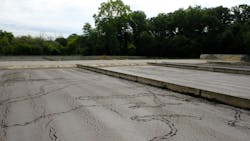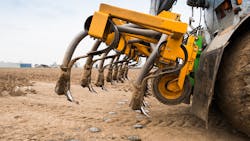How to Use Class A Biosolids
Many governments are now looking to enact stricter controls on biosolids and how they are used. What is a biosolid though, and what does it mean when they are classified as a Class A biosolid? Here is what you need to know about them, and how they can actually benefit certain industries.
What Is Classed As A 'Biosolid'?
In treating waste water, there will be some byproducts in the process. The treated water is put back into the environment, but wastewater treatment facilities are then left with sewage sludge. In the past, this has been considered to be less than ideal, and has been treated as simple waste.
Recently, however, it has been discovered that this sludge can be treated with new technologies, processes that can turn sludge into what is now termed a biosolid. A biosolid is an alternative soil product or fertilizer, and that enables companies to use the product safely in the environment, rather than having to find ways of disposing of it. Most facilities haul them to landfills where the solids decompose.
How The EPA Classifies Biosolids
Now that utilities can process sludge into biosolids, there have been rules drawn up by the U.S. EPA about how they can be used. These have been codified under the 40 Code of Federal Regulations, also known as the Part 503 Biosolids Rule, or CFR Part 503.
This policy has codified exactly how these biosolids are created and used, and the rules apply to all U.S.-based wastewater treatment plants. Several other countries, such as India, are also using similar techniques in their waste management too.
EPA have classified biosolids into two distinct camps. The first are Class A biosolids, which are the highest quality. Any solids that do not quite meet these standards will be sorted into Class B biosolids. While this is a simplified version of the process, there are lots of different things that have to be considered to ascertain overall quality.
The main difference is that Class A biosolids will not register any pathogens when measured.
“Class A biosolids are most typically produced by anaerobic digestion and extra treatments, like heating, pasteurization, composting, and so on” said Sahil Tashan, a technical writer. “This will allow them to gain that status and be used for several different applications.”
Applications Of Biosolids
Once those biosolids have been created, what can they be used for? In the EPA ruling, there are three different use cases for both Class A and B biosolids.
1. Land Application
This is where wastewater utilites can use these biosolids on non public sites, such as agricultural land, forests and reclamation sites. They can also be used on public sites, such as golf courses, plant nurseries, and roadsides. All Class A and B biosolids can be used in this way, as long as they meet proper requirements and standards.
2. Surface Disposal
This refers to the placement of the biosolids in a specific waste disposal site. This can include monofils, lagoons, surface impoundments, and so on. Disposal in a municipal landfill does not fall under this category, and those would need to meet a separate regulation requirement to dispose of biosolids in this way. At disposal sites, there should be precautions in place to ensure that no harm will come to crops or animals that may be near the disposal site.
3. Incineration
Finally, biosolids can be incinerated. To do so, they will need to be heated at very high temperatures in an enclosed device. Air pollution control devices will also be needed to ensure that environmental damage from this method of disposal is minimal.
Use of Biosolids in Agricultural Settings
Over the last few years, there has been a growing trend of using Class A biosolids for use in agricultural settings. This is not surprising, as it allows for former waste products to be made into something useful, and that makes it beneficial to the industry.
This recycling of waste products is attractive, as it makes it a very ecologically sound fertilizer. As well as this, it makes it cheaper too. The cost of handling, treating and using sewage sludge is a lot less than other methods, so industry has been inclined to take this approach.
“There's so much support for the use of biosolids that you'll see regulatory actions are catching up with demand” wrote Jen Winters, a writer with OriginWritings. “Even in the U.S., where land filling of biosolids is allowed, you'll see only about 22% ended up in landfill vs. the 51% used on land.”
There are many disadvantages that would come from land filling biosolids, namely the costs associated with hauling and landfilling. Compared to the advantages of land application, it is clear it has become a popular choice.
It is also important to note that not all states or regions approach biosolids in the same way. For example, the Maine state legislature earlier this year — both House and Senate — passed a bill to ban biosolids land application due to PFAS contamination with L.D. 1911. So while there are approved methods, it is important to follow local and state rules related to their use.
The Benefits Of Land Application
So why is land application one of the best ways of using biosolids? There are several reasons why this is the case.
1. A Good Source of Soil Nutrients
One of the best things about Class A biosolids is that it is a good source of nitrogen and phosphorus. Typically this would come from phosphate rocks. Those rocks are a non-renewable resource, however, so they are not ideal. Biosolids, on the other hand are more natural and renewable, making it more ecologically sound.
2. Replace Conventional Fertilizer
Conventional fertilizers have some downsides, such as being carbon intensive. Peat based soil is also problematic, as it destroys peat lands and releases large amounts of carbon. Using biosolids allows agricultural users to avoid these problems.
3. Reclaim Land
There are areas that typically cannot be used for agriculture or other uses. Surface mines, for example, are a good example of this. Class A biosolids allow communities to replenish the land and put it to use.
4. Improve Soil
The components that make up a Class A biosolids help improve soil's water holding capacity and structure, making it much more capable of growing crops. As such, this is something that many farming systems take advantage of.
5. Reduce Incineration
When biosolids are incinerated, it can release dangerous gases into the air, although air regulations are in play with this method. This will happen even if care is taken to avoid this; however, if land application is used instead of incineration, it will drastically reduce those emissions. Incineration also requires a lot of energy use to keep the heat high in the incinerator for destruction of the biosolids, which can be costly.
6. Affordability
Depending on how the biosolids are treated, following one of the three approved methods to dispose of sewage sludge as biosolids can be more affordable in the long term. And if the biosolids meet requirements, they can be sold for land application.
7. Recycle Food Waste
It is not just sewage sludge that can be recycled with biosolids land application. The process of creating biosolids can also be applied to food scraps and leftover material, thanks to the anaerobic digestion used in biosolids creation. As such, it creates a circular method of recycling these leftovers.
Biosolids are offering a better way of dealing with wastewater treatment byproducts. They can be turned into something that benefits the land, and can be more ecologically friendly as well.


